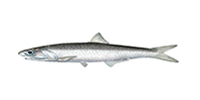Thank you for visiting the Seafood Selector. EDF is planning a new approach to providing information to consumers about good seafood choices. Please come back soon for updates.
Anchovy

Northern Anchovy
Recommended servings per month
| Contaminant | Men | Women | Kids 6-12 | Kids 0-5 | |
|---|---|---|---|---|---|
| European anchovy (Adriatic Sea) | Mercury | 4+ | 4+ | 4+ | 4+ |
| Japanese anchovy | Mercury | 4+ | 4+ | 4+ | 4+ |
| Northern anchovy | Mercury | 4+ | 4+ | 4+ | 4+ |
| Anchoveta | Mercury | 4+ | 4+ | 4+ | 4+ |
| European anchovy (Black & Mediterranean Seas) | Mercury | 4+ | 4+ | 4+ | 4+ |
Eco details:
- Only a fraction of the world's anchovy catch is destined for your dinner plate — most are processed into fishmeal and fish oil for use in animal feeds, food additives, fertilizers and dietary supplements.
- Anchovies, which have short life spans and reproduce quickly, are resilient to fishing pressure and remain plentiful.
- Most edible anchovies sold in the U.S. are European anchovies (although small amounts of other species are also canned).




